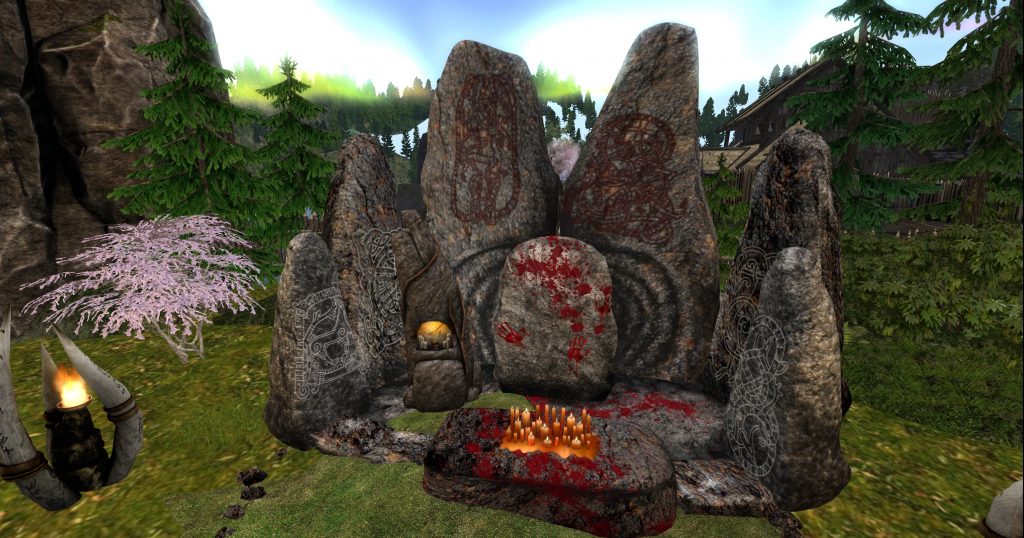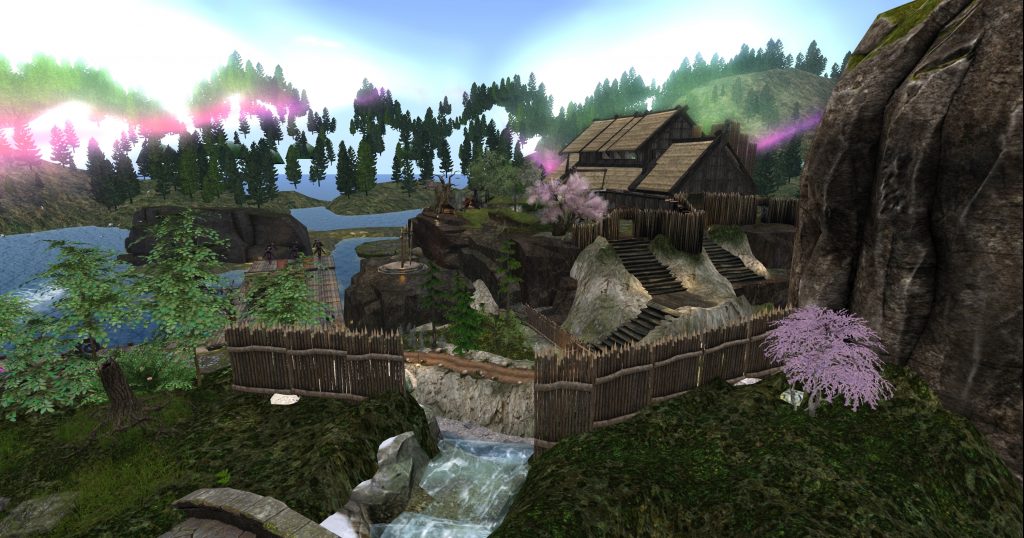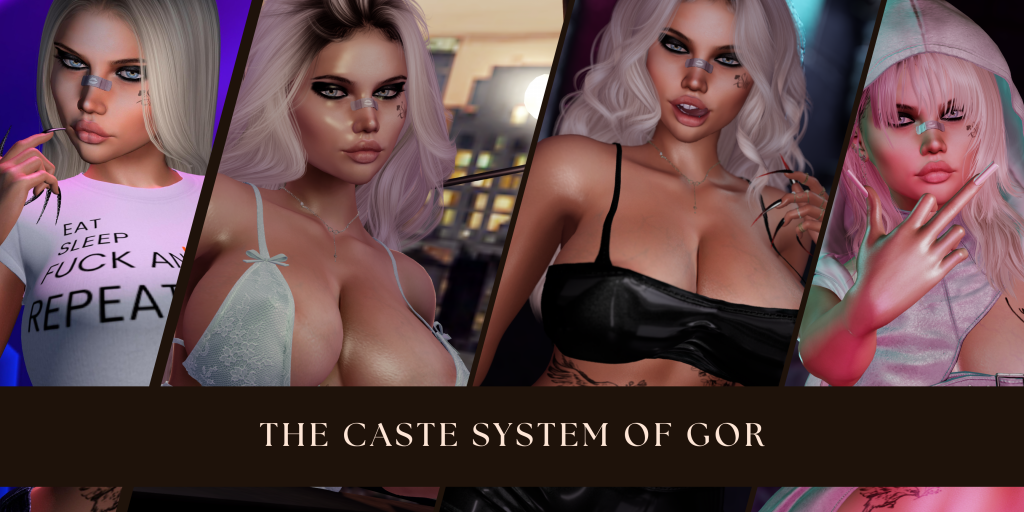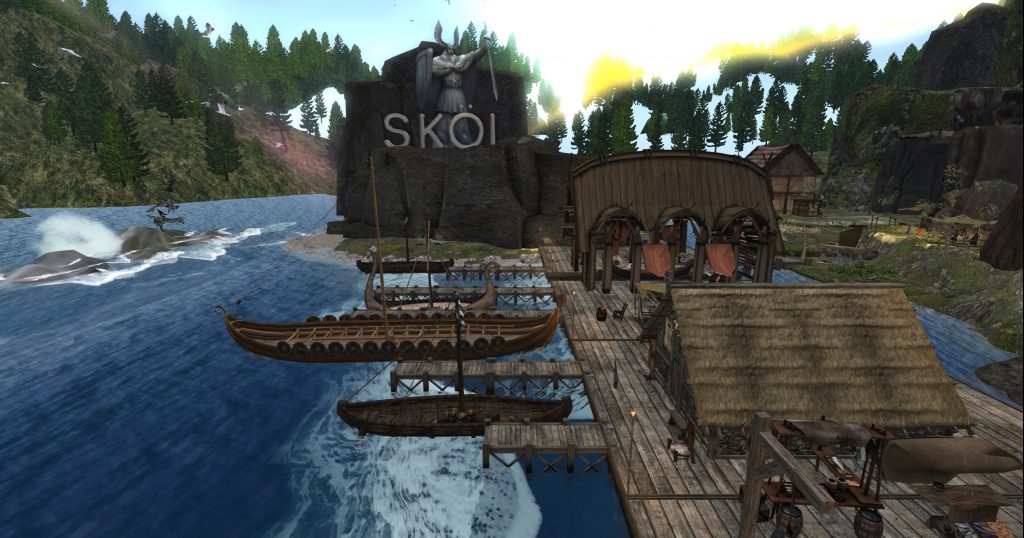Last Updated on: 25th April 2024, 10:52 am
Gor Roleplay in Second Life has been around since pretty much the start of Second Life. It’s quite a popular thing too, or at least it was. Gor, in recent years has seen a massive decline since the release of Conan Exiles. Simply put, it’s a roleplay allows you to be a character in a world modelled after John Norman’s Gorean books. You might step into the boots of a warrior, or find yourself in chains as a slave. Both under a complex social hierarchy that mimics an ancient Earth-like civilization, with power struggles and strict roles.
At a glance, it might seem clear cut—men hold power and women serve. But is it that straight forward? This lifestyle within Second Life does challenge people to go through a scenario where roles are predefined by gender. However, the story each person is telling is their own..
This post has been brewing for almost eight months now. Not because I’ve been immersing myself in Gor—it’s the opposite. My exploration has been from the outside looking in, and so I will say that I am not claiming to be an expert by any means. Some of you may correct me in the comments and I hope you do if I miss the mark. But I have consumed hours of research, conversations with people who breathe life into these characters, watched countless videos, and reading written content on the topic. All to find an informed perspective without ever stepping foot into the Gorean life myself. I could never do it. Every bone in my body is against being submissive or someone’s slave and I personally could never put myself in that position.
But what makes its heart beat? Why do people return? How does it affect their “real-life” persona? Lets take a look at one of the most intriguing aspects of Second Life.

What is Gor roleplay in Second Life?
Gor Roleplay once crowned itself as one of the top role-play themes within Second Life. It offers residents a chance to jump into a world inspired by John Norman’s novels — a brutal universe where sexual slavery is rampant, portrayed in settings reminiscent of ancient Roman, Viking, or tribal civilizations.
What sets the Gor Roleplay apart is the formation of Gorean sim communities. Think of these as either closed or semi-closed groups that knit tightly together, almost mimicking real-life communities. Different from typical gaming worlds governed strictly by predefined game design rules, the Gor communities in Second Life set their own guidelines. This autonomy allows them to have a unique community life.
Interestingly, while Norman’s novels depict a deep appreciation for the environment and surroundings, this aspect doesn’t often translate into the Second Life roleplay. However, the discrepancy doesn’t end there.
A big difference lies in the portrayal of gender roles. While the prevailing belief in Second Life relegates all women to slavery, Norman’s text reveals a different scenario where only 1 in 1000 women become slaves, and the rest remain freewomen.
Reolplayers might follow different styles like Gor Evolved (GE) or By The Book (BTB), each bringing its own aspects.
The novels set on the fictional planet of Gor have not escaped criticism, facing accusations ranging from bigotry to sexism. These critiques are forming part of a wider discussion. One that has been tackled extensively by others more focused on dissecting literary criticisms than myself.

The History and Origins of Gor roleplay in Second Life
The popular science fiction novels written by the already mentioned John Norman trace the origins of Gor roleplay. The first book in the series, “Tarnsman of Gor,” was published in 1966 and introduced readers to the planet of Gor. A parallel world where technology and slavery coexist. The series went on to become a cult favourite among fans of science fiction and fantasy, with over 30 books published to date.
In the early 2000s, the concept of bringing Gor to life in a virtual setting emerged, and Second Life became the perfect platform for it. The flexibility and creativity offered by Second Life made it a perfect choice for the Gor roleplay community to build their own version of the Gorean planet.
Since its inception, Gor roleplay in Second Life has evolved and grown, with regions, communities, and events catering to the passionate fanbase. People from all around the world come together in these sims to take part in battles, forge alliances, and immerse themselves in the lore and history of Gor.

Gorean Transplanted Cultures
A central aspect of the Gorean universe is the concept of transplanted cultures. At various times, the Priest Kings reportedly gathered samples of human cultures from Earth and relocated them to Gor. This set the stage for these cultures to grow into cities, settlements, and empires on this parallel world.
Gor’s culture includes the Greco-Roman culture, which pervades the civilized parts of Gor and its islands. There’s the pre-Christian Norse culture living in Torvaldsland, and the Shogunate Pani Islands that draw directly from Japanese history. The Native American-influenced culture of The Barrens, the Mongolian Tuchuks, the Bedouin tribes of the Tahari, and the Zulu-influenced empire of Bila Hiruma in the jungle interiors further further this cultural jigsaw.
Interestingly, while Chinese and South Asian influences are absent, hints suggest that Bazi might draw from these cultures. This omission, along with many uncharted territories, presents a chance for players interested in making new Gorean cultures or putting their own twist on the existing Gorean world.

Beyond these established areas, the novels sketch many Gorean cities in only the faintest outlines, offering just glimpses of their cultural fabric. For instance, the city of Harfax, with its Anglo-Saxon names, hints at a medieval English influence. Moreover, subtle clues in the etymology of other Gorean settlement names open doors for further development and exploration by the community.
Additionally, whispers suggest that a lost Mesoamerican culture hides in the deeper jungles of Gor, waiting to be discovered.

Sex & Gender in Gorean Roleplay
The Gorean world, as written by John Norman, operates largely on a “might makes right” philosophy. Here, might extends beyond physical strength to include intellectual and economic power. It’s a world ruled by savagery and cruelty, where political and social power often correlates directly with the strength of a weapon. However, the way it is structured means that most political and nearly all military power is typically held by men.
Challenging Conventional Roles in Gorean Society
While Gorean society typically constrains the roles of men and women—reflecting stratification by both caste and gender—the act of defying these roles makes character play in Gor so compelling.
The Power and Influence of Women in Gor
Upon looking deeper into Norman’s novels for research, it became clear that women in Gor are far from powerless. Initially, discussions within the Second Life community solely shaped my understanding of Gor, but the novels provided new insights.
For instance, in “Outlaw of Gor,” there’s an entire city, Tharna, ruled by women who had seized control from the traditional male-dominated hierarchy. Although eventually overthrown, women were the undisputed rulers here, completely reversing the usual power dynamics by subjugating men.
In “Tribesmen of Gor,” we meet Tarna, a bandit leader who breaks the conventional gender norms by using weapons and demonstrating skill with the scimitar.
Verna is the leader of a band of panther girls, who shows complete defiance against Gor’s societal norms. She leads a group that uses scarification and self-mutilation as a rebellion against Gorean beauty standards and to renounce their value as slaves.
Furthermore, the plots of the Kur often hinge on women, particularly those from Earth, who execute complex schemes that influence the destiny of worlds, such as in “Conspirators of Gor.” The Lady Bina, initially a mute grooming slave of the Kur, emerges as a formidable figure who, with Grendal by her side, aims to seize control of Gor.

The Spectrum of Female Roles
Within Gor, women are not monolithic. They are huntresses, doctors, leaders, and yes, slave girls. Some use subtle control over their masters, effectively “topping from the bottom,” . Others, like Tarna, have male silk slaves to cater to their desires.
And yet, if you go to any Second Life Gorean roleplay sim, you will rarely find anything like this other than the Panthers.

The Caste System of Gor
Gor operates on a caste system that defines each group by its profession. The caste a person belongs to dictates everything from social status to daily interactions. There are several castes, each having its own hierarchy and often, specialized sub-castes designed for specific professional needs.
Sub-Castes and Their Significance
For example, within the caste of Merchants, you find the Slavers. These individuals focus solely on the trade of humans. Their job is who they are and their place in Gorean society.
Despite the hereditary nature of castes, there is room for movement based on personal skills and abilities. Changing one’s caste isn’t common, but it is possible for those who show something that aligns better with another caste’s functions.
Codes of the Caste
Every caste operates under a strict set of guidelines called “codes”. These dictate everything from how members perform their roles to how they interact with others. Living by these codes is important for maintaining order and respect within and between castes.
Each major caste also has specific colours known as the “Caste Colours”. These are worn by members and serve more than decorative purposes. They signal one’s professional identity and societal role. From flags to clothing, these colours are a quick identifier in the Gorean social structure.
Examples of Major and Minor Castes
- High Castes:
- Initiates (White): They act as the spiritual leaders and carry great responsibility but are often viewed with suspicion.
- Scribes (Blue): They keep records, write histories, and are crucial to knowledge preservation.
- Builders (Yellow): This caste includes architects and engineers, fundamental to the development of infrastructure.
- Physicians (Green): Respected healers who are crucial in times of war, recognized for their non-combatant status.
- Warriors (Scarlet): Defenders and soldiers, embodying strength and strategic skills.
- Notable Low Castes:
- Merchants (White and Gold): They handle trade and goods.
- Slavers (Blue and Yellow): Specialized merchants in the human trade market.
- Bakers (Orange and Brown): Key players in food production, focusing on vegetarian preparations.
The caste system in Gor is a comprehensive lifestyle guideline that influences social status, interpersonal relations, and even legal rights. It’s a system that demands respect for tradition and adherence to deeply ingrained societal norms. Stretching from the highest ranks of warriors and priests down to bakers and slavers, it’s a framework that touches every aspect of life on Gor, making it a foundational element of the Gorean narrative.

What is a Gorean Slave?
Slavery in the world of Gor, as depicted in the Books of Gor, is an important and widely accepted part of the society.
In Gorean society, several categories with specific names divide the slaves: the female slave is known as a kajira (plural kajirae), and the male slave as a kajirus (plural kajiri). Other terms like Sa-fora, meaning “Daughter of the Chain,” and Mul, which stands for a human slave as termed by the Priest Kings exist. With so many different names, is shows how embedded the nature of slavery is within the society.
The Paradoxical Status of Women in Gorean Slavery
Slavery, especially for women, portrays both subjugation and a perverse form of empowerment. The narrative describes female slaves, or kajirae, as reaching their full potential only upon becoming slaves, a process during which they ignite “slave fires” within themselves. The books argue that free women, often depicted as bitter and envious of kajirae, lack value because their pricelessness renders them, paradoxically, worthless. In contrast, enslaved women have a definitive value established by what men are willing to pay for them.
Enslavement is considered a permanent state in Gorean philosophy. There’s a saying in Gor that “it is only a fool who frees a slave girl,” which shows the deeply ingrained belief in the irrevocability of a woman’s enslavement.
Legal Non-Existence of Slaves
A quote from “Outlaw of Gor” sums up the legal standing of slaves: “On Gor a slave, not being legally a person, does not have a name in his own right, just as, on Earth, our domestic animals, not being persons before the law, do not have names.” This comparison to domestic animals shows the utter lack of personal identity and rights granted to slaves within Gorean society.
The Singular Purpose of a Gorean Slave
The ultimate purpose of a slave in Gor is singular—to please their owner. This is the uncomplicated truth that underpins the complex social and legal structures surrounding slavery in Gor. It’s a controversial and multifaceted aspect of Gorean society.
Well, controversial for some. Not for a woman who takes pride in owning her slaves. *smile*

What is Gorean Philosophy? | Gor Roleplay in Second Life
In Gor, the notion of the Natural Order is a way of life that deeply influences the societal structure and individual behaviours. This philosophy asserts that men and women are fundamentally different in numerous aspects, from physical appearance to psychological makeup. Basic human biology, shaped by evolution, predisposes each sex toward specific behaviours and emotional responses, rooting these differences.
The Principle of Authenticity: “Be What You Are”
Drawing parallels to the philosophies of Earth’s Marcus Aurelius, Gor urges people to embrace their unique nature. The Gorean mindset dismisses the idea of assuming the properties of another entity as inherently problematic.
Social Identity and Caste Mobility: “Be Who You Are”
This Gorean philosophy recognizes that while everyone is born into a specific caste, innate talents and abilities should guide one’s social mobility. However, changing one’s caste is rare as many Goreans hold their familial caste in high regard, viewing it as a core part of their identity.
Acceptance of Innate Roles: “Obey the Natural Order of Things”
Goreans believe that opposing the natural predispositions formed by generations of evolution is futile. In this society, attributes such as strength, intelligence, and ambition are expected to define one’s social standing. Gender roles are also pronounced, with men typically viewed as the dominant protectors and providers, while women, considered physically smaller and less potent, are expected to leverage their emotional intelligence and endurance to support men and ensure the survival of the species.
Self-Actualization Within Society: “Do What You Will”
A central tenet in Gorean philosophy is the pursuit of self-fulfilment within the confines of one’s societal role. Whether as a warrior, a free woman, or a slave, each person is aiming for personal success and contributing to the greater good of Gorean society.
Accountability for Actions: “Responsibility for One’s Actions”
The concept of “cause and effect” is fundamental in Gor. Each decision, whether it’s a warrior drawing his sword or an individual embracing slavery, carries inevitable consequences. Making sure that every action has an awareness of its potential impact. Pulling the society together in a web of interdependent decisions and outcomes.
These principles form the bedrock of Gorean philosophy, dictating interactions and shaping the society. They highlight a culture that values stark differentiation between genders, a clear social structure, and the importance of personal responsibility, all tied together by a deep-seated belief in the natural order of life.

Getting started with Gor roleplay in Second Life
Ok, so now we’ve looked at the basics of Gor roleplay in Second Life. Now we look at how you can get involved. Starting with Gor roleplay in Second Life is easy. Here are a few steps to help you jump into this world:
1. Create a Second Life account: If you haven’t already, head over to the Second Life website and sign up for an account. It’s free to join, and you’ll have access to the basic features of the platform.
2. Customize your avatar: Once you’ve created your account, it’s time to design your avatar. Choose your appearance, select your clothing, and add any accessories or weapons that suit your character concept.
3. Find Gor regions: In Second Life, there are various regions dedicated to Gor roleplay. Use the search function or ask other players for recommendations to find the most active and immersive Gor regions.
4. Read the rules and guidelines: Gor roleplay in Second Life has its own set of rules and guidelines to. Take the time to familiarize yourself with these rules to avoid any misunderstandings or conflicts.
5. Engage with the community: Attend events, join groups, and start conversations with fellow players.

Choosing your Role and Character in Gor Roleplay in Second Life
In Gor roleplay, players have the freedom to choose from a range of roles and characters, each with its own set of attributes and responsibilities. Whether you prefer to be a warrior, a politician, a craftsman, or a slave, there are countless possibilities for character creation in Gor roleplay.
When choosing your role and character, consider the following:
1. Personal preferences: Think about what type of character resonates with you the most. Do you prefer a dominant or submissive role? Are you drawn to combat or politics?
2. Lore and background: Gor roleplay is deeply rooted in the lore and history established by the novels. Familiarize yourself with the Gorean culture, social structure, and customs to create a character that fits.
3. Skills and abilities: Each role in Gor roleplay comes with its own set of skills and abilities. Warriors are skilled in combat, slaves excel in submission and service, while craftsmen have specific trade skills.

Etiquette and Rules in Gor Roleplay
Gor roleplay in Second Life brings its own set of etiquette and rules that players are expected to follow.
Here are some important etiquette and rules to keep in mind:
1. Respect consent: Consent is a crucial aspect of Gor roleplay. Always ask for consent before engaging in any form of roleplay that may involve sensitive or intimate situations. Respect the boundaries and comfort levels of other players, and be open to communication and negotiation.
2. Stay true to the lore: Gor roleplay is building on a rich and detailed lore established by the novels. Stay true to the core principles and customs of Gor, and avoid introducing elements or concepts that contradict the established lore.
3. Communicate clearly: Effective communication is essential in Gor roleplay. Clearly express your intentions, actions, and thoughts to other players, both in character and out of character.
4. Follow region rules: Each Gor region in Second Life may have its own specific rules and guidelines. Familiarize yourself with these rules and make sure that you follow them at all times. Ignoring or violating region rules can lead to consequences and detract from the overall roleplaying experience for everyone.
5. Be patient and understanding: Gor roleplay is a collaborative experience, and not everything will go according to plan. Be patient and understanding with other players, and be open to unexpected twists and turns in the storyline. Remember that conflict and challenges are an important part of Gor.

Joining a Gor Roleplay Community or Group
Here’s how you can find and join a Gor roleplay community or group:
1. Search in-world: Utilize the search function in Second Life to find Gor roleplay communities or groups. Look for keywords such as “Gor roleplay,” “Gorean community,” or specific roleplay factions that interest you.
2. Attend events: Many Gor roleplay communities host regular events, such as battles, celebrations, or political gatherings. Attend these events to meet other players and get a feel for the community dynamics.
3. Ask for recommendations: Reach out to other players in Gor regions or online forums and ask for recommendations on active and welcoming Gor roleplay communities. Experienced players can provide great insights and help you find the right community to join.
5. Introduce yourself: Joining a Gor roleplay community is an opportunity to introduce yourself and your character to the group. Take part in conversations, go to community gatherings, and participate in roleplay scenarios to build connections and become an active member of the community.

Further Resources
There you have it. A breakdown of Gor roleplay in Second Life. Did I get anything wrong? Additionally, did I miss anything important? Please let me know in the comments below. And, if you’re still looking for more information then here are some useful links to more resources about the Gorean life in Second Life.
What’s different about Second Life Gor Roleplay
The Gorean Community in Second Life: Rules of Sexual Inspired Role-Play



Gor is empty in recent times and the roleplay is unfortunately dull. The average Gorean has never read a book and it is a very hateful genre.